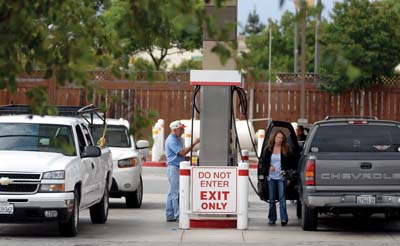The San Benito County Board of Supervisors has approved the
establishment of 23 new oil wells in southern San Benito County.
The area, which is called
”
Vallecitos Field
”
and is more than 50 miles south of Hollister, has been drilled
for oil since 1910 but in recent years has been considered a very
dry and low-volume oil-drilling area.
The San Benito County Board of Supervisors has approved the establishment of 23 new oil wells in southern San Benito County.
The area, which is called “Vallecitos Field” and is more than 50 miles south of Hollister, has been drilled for oil since 1910 but in recent years has been considered a very dry and low-volume oil-drilling area.
The 23 new wells, which are spread across six different companies and properties, are described as exploratory wells in hope that they find a new stream of oil.
“There was quite a bit of oil and a lot of it was pumped out,” Assessor Tom Slavich said. “Now you are left with the deposits.”
Slavich added that there was “substantially less” oil in the region than decades ago.
“I think they did a certain study and they are probably assuming there is more oil down there,” he said. “They are going to try and do some exploratory drilling.”
He warned that it was a “hit and miss” type of risk that the companies were undertaking. The six landowners will next have to present their plans to the planning department for approval. If approved, the United States Geological Survey will monitor the drilling, Slavich said.
The board passed each application unanimously.
Santa Cruz-based Patriot Resources controls five of the six lands that applied for well approval. The company has been a part of oil drilling in the south county since the late 1980s when it bought the wells from Shell Oil. Currently, Patriot Resources has four active wells that produce 10 to 12 barrels a day total.
“That’s very, very low volume,” said Steve Coombs from the group. “Their economic heyday was many, many years ago.”
The low deposits prompted Patriot Resources and the landowners to look for more oil reserves, Coombs said.
“If you make a new discovery it would be a much higher volume of oil,” he said.
If they didn’t look for new oil reserves now, the current wells would dry up soon, Coombs said.
“We are at the very end of its life,” he said. “You have to continue to produce it and look for different opportunities.”
All the applicants must follow guidelines set by the Williamson Act, which is a land conservation act that was passed in 1965, Slavich said. The oil wells must not have a huge impact on the land.
All of the new wells on the six pieces of land take up less than 1 percent of each property, causing a low impact on the land, Slavich said.
See an expanded story in the Pinnacle on Friday.










